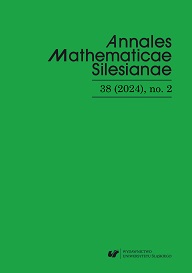Y. Alp and E.G. Koçer, Hybrid Leonardo numbers, Chaos Solitons Fractals 150 (2021), Paper No. 111128, 5 pp.
Google Scholar
Y. Alp and E.G. Koçer, Some properties of Leonardo numbers, Konuralp J. Math. 9 (2021), no. 1, 183–189.
Google Scholar
A.T. Benjamin and J.J. Quinn, Proofs that Really Count: The Art of Combinatorial Proof, Mathematical Association of America, Washington, DC, 2003.
Google Scholar
M. Bicknell-Johnson, Divisibility properties of the Fibonacci numbers minus one, generalized to C_n = C_{n-1} + C_{n-2} + k, Fibonacci Quart. 28 (1990), no. 2, 107–112.
Google Scholar
M. Bicknell-Johnson and G.E. Bergum, The generalized Fibonacci numbers fCng,
Google Scholar
C_n = C_{n-1} + C_{n-2} + k, in: A.N. Philippou et al. (eds.), Applications of Fibonacci Numbers, Kluwer Academic Publishers, Dordrecht, 1988, pp. 193–205.
Google Scholar
D. Birmajer, J.B. Gil, and M.D. Weiner, (an+b)-color compositions, Congr. Numer. 228 (2017), 245–251.
Google Scholar
P. Catarino and A. Borges, A note on incomplete Leonardo numbers, Integers 20 (2020), Paper No. A43, 7 pp.
Google Scholar
E.W. Dijkstra, Fibonacci numbers and Leonardo numbers, EWD797, University of Texas at Austin, 1981. Available at www.cs.utexas.edu.
Google Scholar
E.W. Dijkstra, Smoothsort, an alternative for sorting in situ, Sci. Comput. Programming 1 (1981), no. 3, 223–233.
Google Scholar
T. Goy and M. Shattuck, Determinant formulas of some Toeplitz–Hessenberg matrices with Catalan entries, Proc. Indian Acad. Sci. Math. Sci. 129 (2019), no. 4, Paper No. 46, 17 pp.
Google Scholar
T. Goy and M. Shattuck, Determinants of Toeplitz–Hessenberg matrices with generalized Fibonacci entries, Notes Number Theory Discrete Math. 25 (2019), no. 4, 83–95.
Google Scholar
T. Goy and M. Shattuck, Determinants of some Hessenberg–Toeplitz matrices with Motzkin number entries, J. Integer Seq. 26 (2023), no. 3, Art. 23.3.4, 21 pp.
Google Scholar
T. Goy and M. Shattuck, Hessenberg–Toeplitz matrix determinants with Schröder and Fine number entries, Carpathian Math. Publ. 15 (2023), no. 2, 420–436.
Google Scholar
Z. İşbilir, M. Akyiğit, and M. Tosun, Pauli–Leonardo quaternions, Notes Number Theory Discrete Math. 29 (2023), no. 1, 1–16.
Google Scholar
N. Kara and F. Yilmaz, On hybrid numbers with Gaussian Leonardo coefficients, Mathematics 11 (2023), no. 6, Paper No. 1551, 12 pp.
Google Scholar
A. Karataş, On complex Leonardo numbers, Notes Number Theory Discrete Math. 28 (2022), no. 3, 458–465.
Google Scholar
K. Kuhapatanakul and J. Chobsorn, On the generalized Leonardo numbers, Integers 22 (2022), Paper No. A48, 7 pp.
Google Scholar
F. Kürüz, A. Dağdeviren, and P. Catarino, On Leonardo Pisano hybrinomials, Mathematics 9 (2021), no. 22, Paper No. 2923, 9 pp.
Google Scholar
M. Merca, A note on the determinant of a Toeplitz–Hessenberg matrix, Spec. Matrices 1 (2013), 10–16.
Google Scholar
T. Muir, The Theory of Determinants in the Historical Order of Development. Vol. 3, Dover Publications, Mineola, NY, 1960.
Google Scholar
A.G. Shannon, A note on generalized Leonardo numbers, Notes Number Theory Discrete Math. 25 (2019), no. 3, 97–101.
Google Scholar
A.G. Shannon and Ö. Deveci, A note on generalized and extended Leonardo sequences, Notes Number Theory Discrete Math. 28 (2022), no. 1, 109–114.
Google Scholar
M. Shattuck, Combinatorial proofs of identities for the generalized Leonardo numbers, Notes Number Theory Discrete Math. 28 (2022), no. 4, 778–790.
Google Scholar
N.J.A. Sloane (ed.), The On-Line Encyclopedia of Integer Sequences. Published electronically at https://oeis.org, 2023.
Google Scholar
Y. Soykan, Generalized Leonardo numbers, J. Progressive Res. Math. 18 (2021), no. 4, 58–84.
Google Scholar
R.P. Stanley, Enumerative Combinatorics. Vol. 1, Cambridge University Press, Cambridge, 1997.
Google Scholar
E. Tan and H.-H. Leung, On Leonardo p-numbers, Integers 23 (2023), Paper No. A7, 11 pp.
Google Scholar
R.P.M. Vieira, M.C.S. Mangueira, F.R.V. Alves, and P.M.M.C. Catarino, The generalization of Gaussians and Leonardo’s octonions, Ann. Math. Sil. 37 (2023), no. 1, 117–137.
Google Scholar



 10.2478/amsil
10.2478/amsil